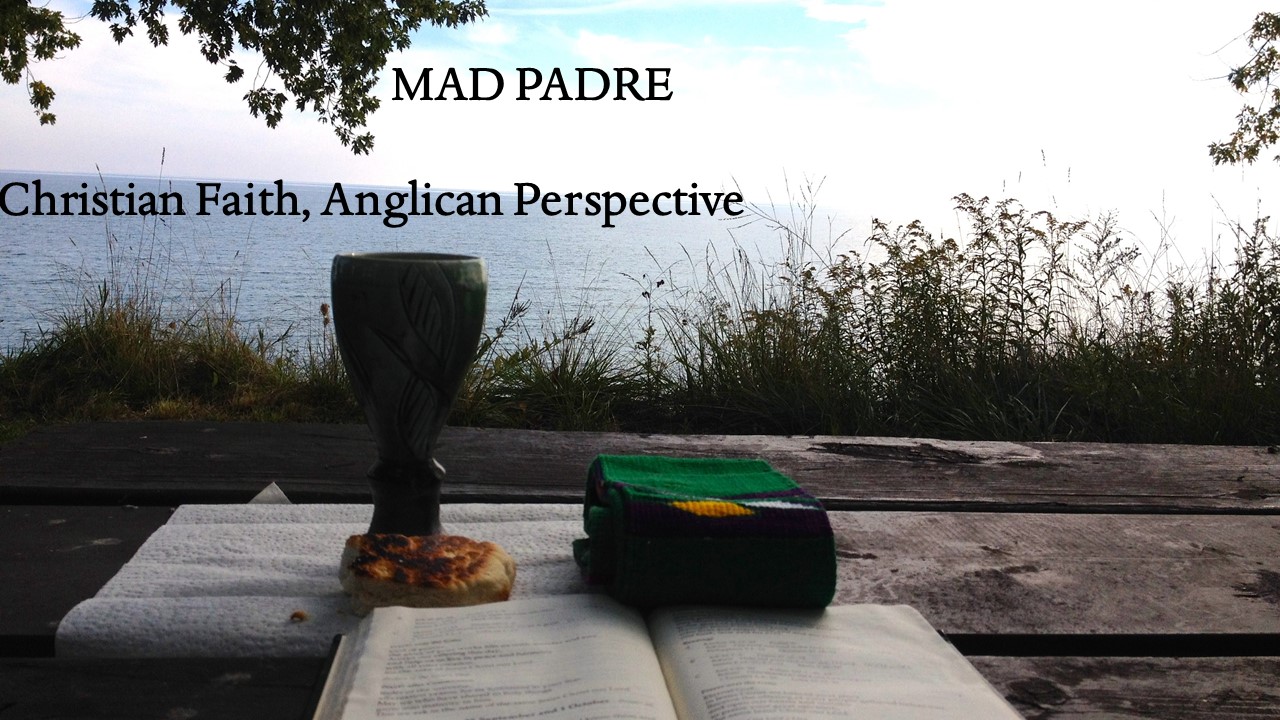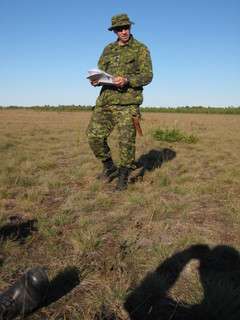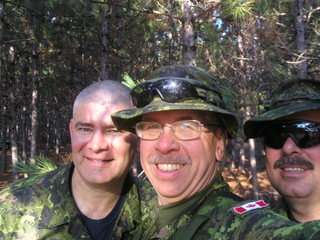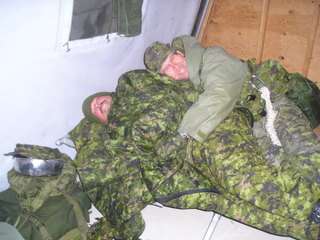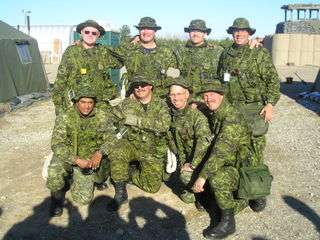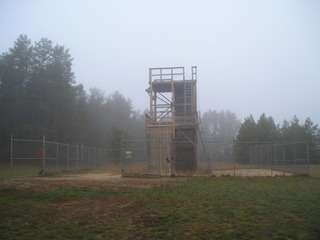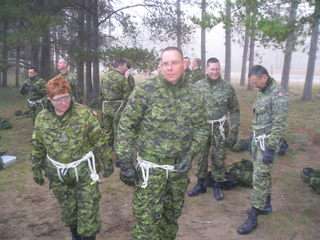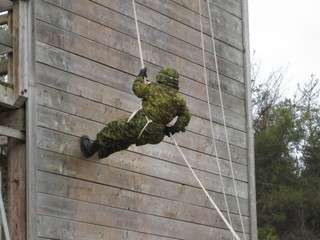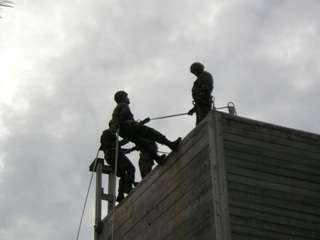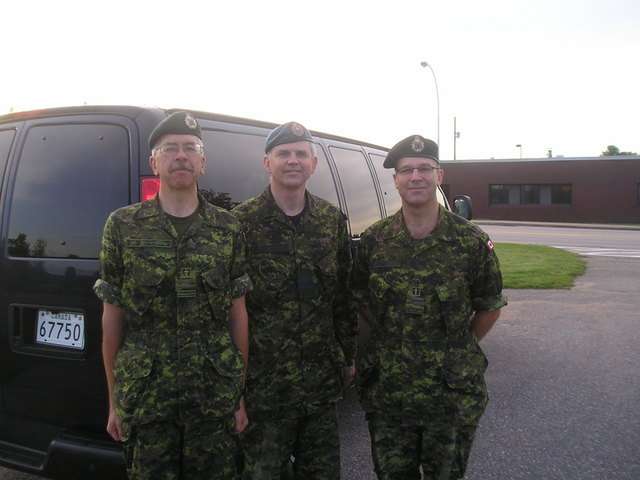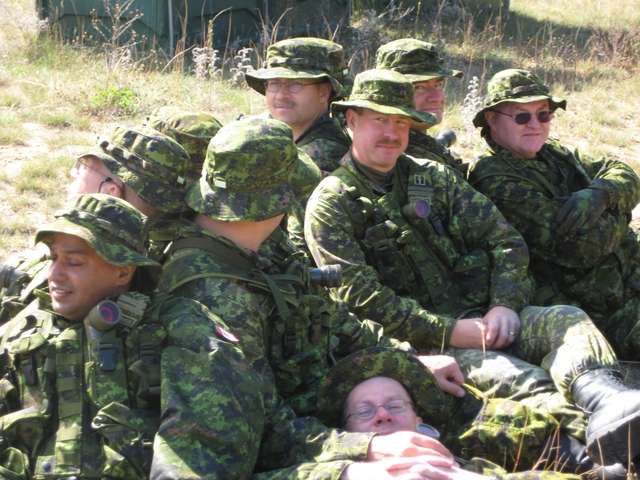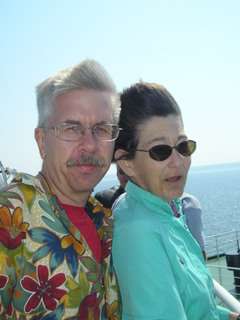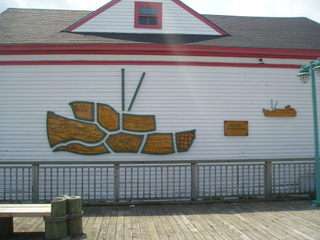After three months away from the pulpit, it's a blessing to be able to preach again. This sermon is to be preached tomorrow at St. Mark's chapel, CFB Greenwood.2 Samuel 7:1-11, 16, salm 89:1-4, 19-26, Romans 16:25-27, Luke 1:26-38
"Then Mary said, “Here am I, the servant of the Lord; let it be with me according to your word.” (Luke 1:38)
As most of you know, I’ve recently returned from three months basic training at the chaplain’s school in Borden, Ontario. Our training prepared us for military service by focusing on drill, discipline, rank structures, fieldcraft and other essential survival skills. By the end of the course, we had some idea of what would be expected of us as soldiers. But we weren’t just training to be soldiers, we were training to be chaplains, and that required a different mindset. To use military jargon, it wasn’t enough to learn how to be (army) green, we had to learn how to be (chaplain) purple.
Several years ago, the Chaplain’s branch adopted new cap badges and a new motto, to reflect the fact that our branch is no longer just a Christian institution. The new motto reminds us that whether we are Christian, Jew, Muslim or some other faith, we all have the same mission. We are all “Called to Serve”.
Now if you are forced to spend three months up close and personal around 24 other people, being forced to work as a team, you learn a fair bit about service. You learn to help the other fellow learn to shine his shoes, because he in turn may be good with an iron and can help you with your dress uniform.
You learn to admire the various ways in which people are gifted. The strong chap who inspired you on a rucksack march and helped you set up your tent might struggle in the classroom and need help with academics.
As talents and gifts became obvious, it was tempting to look at one and say “He’s young, smart, and bilingual – he could be the next Chaplain General”, and to look at the other and say “He’s forty something and a real plodder, he’ll be stuck in Cold Lake as a Captain for Life”.
I found it very tempting to fall into this career-oriented thinking, and whenever I did so, I always tried to ask myself, Am I called to serve?, or am I called to serve myself?
Borden was thus a time of preparation for my colleagues. We learned more about who we were, and how we might live out our callings in the Canadian Forces. Hopefully we graduated feeling more prepared and more willing to take on the challenges of these callings.
Likewise, these four weeks have been a time of preparation for us as church. Advent is a Latin word (advenio) meaning “coming” or “coming to”. Our worship began this morning with the hymn “People look East”, reminding us to prepare ourselves for God’s coming as if he were a guest coming to our house.
Our custom of lighting the candles of the Advent wreath reminds us of our task to prepare for God’s coming. The Advent wreath is so much more than a four week Christmas countdown. Like the candles or lights we place in a window after dark, or the porch light we leave on, the Advent wreath is a sign that we want to be good hosts, that we are ready for the coming of “love the guest”. All through Advent we have heard voices warning us to prepare for God’s coming. The prophet Isaiah told us to prepare the way of the LORD, make straight in the desert a highway for our God” (Isa 40:3). John the Baptist warned us that “The one who is more powerful than I is coming after me” (Mk 1:7). Now we stand, like the expectant host, taking a last look at our house and our dining room table, praying that everything is ready for the guest who will be at the door at any moment.
Throughout the Bible there are stories of God showing up on people’s doorsteps like an unexpected guest. In Genesis 18, the aged couple Abraham and Sarah entertain three unexpected men who visit their tent. They courteously provide lunch for the visitors, who reveal that God will make Sarah pregnant. The news is too much for Sarah to believe, but God says to Abraham “Is anything too wonderful for the LORD?” (Genesis 18:14). Sure enough Sarah conceives and gives birth to Isaac (Genesis 21:2), and this birth is the first instalment in God’s promise to Abraham that he will be the father of God’s people (Genesis 15).
In Matthew’s Gospel the idea of being prepared for the coming of God is found in the parable of the Wise and Foolish virgins, which ends with the famous verse, “Keep awake therefore, for you know neither the day nor the hour” (Matt 25:13) when God will come. This idea of preparing for God the visitor is famously expressed in the Victorian painting “The Light of the World” by Holman Hunt, inspired by the verse in Revelations, "Behold, I stand at the door and knock; if any man hear my voice, and open the door, I will come in to him, and will sup with him, and he with me" (Rev 3:20). These bible verses and Hunt’s painting are warnings that we never know when God will make demands on us.

All of these stories are of people being called by God to serve, and the greatest of these stories is today’s gospel story of Gabriel visiting Mary (Luke 1:26-38), commonly called the Annunciation. Here Mary has not been consciously preparing for God’s coming into her life – she is just a young girl getting ready to be a bride, just an ordinary small-town girl. However, the angel’s greeting to her as “favoured one” (Luke 1:28) says that there is something about Mary that is pleasing to God. Christians have traditionally focused on Mary’s virginity and purity as her greatest quality, but I think what also makes her pleasing to God is her willingness, her receptiveness to what God wants to do through her. When she learns how God wants her to serve, despite her fears and doubts, she says “Here am I, the servant of the Lord; let it be with me according to your word” (Lk 1:38).
Many have noticed that Mary does not get a choice in God’s plan. Gabriel doesn’t ask her to be a mother, let along a disgraced mother out of wedlock. He simply tells her that “you will conceive in your womb and bear a son, and you will name him Jesus” (Lk 1:38). Some have even called this episode a divine rape, an example of submissiveness that embodies what is wrong with Christianity. Now it is true that God often seems to ignore our plans and choices, and makes decisions for us without consulting us. I remember one preacher’s spouse who made fun of a standard evangelical slogan by saying “God loves you and has a terrible plan for your wife”. But all too often it’s the case that God calls to serve way outside of our comfort zones, doing things that we never envisioned for ourselves. God will knock on our door, as he does with Mary, present us with a done deal and say “I need you to serve me”, and we don’t seem to get a choice.
But who said that we as Christians ever really got a choice in our relationship with God? Some people say that we have to choose to accept Christ as our personal saviour, but isn’t it really the case that God has already chosen us and called us to serve him? Isn’t it the case that in designing us in his image, God wanted us from our very beginnings to want what is good and what is God’s in the world? We didn’t ask to be born, but God gave us life and God wants us to spend that life walking and working with him. God called all of us to serve, whether we go to chaplain boot camp or whether we choose to embrace our callings as parents or as workers or as professionals. We may be called to spend our retirement doing church work or volunteer work while our peers pursue golf and sunny beaches. We may be called to teach others, to befriend others, to heal others, to feed others, the list goes on. The call to serve may be unexpected, it may, like Mary’s call, go counter to what we think our role and our purposes are.
As the preacher Barbara Brown Taylor puts it, "Like Mary, our choices often boil down to yes or no: yes, I will live this life that is being held out to me or no, I will not; yes, I will explore this unexpected turn of events, or no, I will not." You can say no to your life, Taylor says, "but you can rest assured that no angels will trouble you ever again."
Today marks the end of our Advent preparation. On Sunday we will light the white candle at the centre of the Advent wreath, symbolizing the birth of Christ. Love the guest will have arrived. Our spiritual houses may not be as well prepared as we would like. We may not feel ready for God. We may not feel that we have any great calling, or that we have any great gifts to offer. But then again, neither did Mary. All God asked of Mary was to bring Jesus into the world. God will ask the same of us, Christ’s followers, that we leave church and show the light of Christ to the world as Christ’s servants.
Long ago, the Christian writer and mystic
Master Eickhardt wrote these words.
We are all meant to be mothers of God. What good is it to me if this eternal birth of the divine Son takes place unceasingly but does not take place within myself? And, what good is it to me if Mary is full of grace if I am not also full of grace? What good is it to me for the Creator to give birth to his Son if I do not also give birth to him in my time and my culture? Then, then, is the fullness of time: When the Son of God is begotten in us.
This Sunday the angel comes to us as he did to Mary and asks us the same question. “How will you bring the love of God in Jesus to the world?” This is how we are all called to serve. And may our answer be, with Mary, “Here am I, the servant of the Lord; let it be with me according to your word”. Amen.


